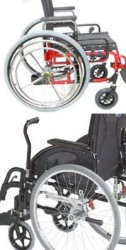We were thinking about getting a one-arm-drive (OAD) for helping with steering and braking, but backed away from the idea, because Rob found it difficult to use and they are also not very intuitive and take a lot of thought to operate. I think he would have spent all his energy thinking about it, which kind of defeats the point. They are also very expensive.
Since researching one-arm-drive systems initially, it is clear that the technology is just not really there still. Probably the best example was the Nomad system, but they are no longer in business. As far as I am aware, the only ones currently being sold are by Invacare, Sunrise Medical and Drive Medical for some of their lower level folding wheelchairs.
Overview of One Arm Drives (OAD)
Below is a copy from a good overview of One Arm Drive Systems. It is primarily for folding wheelchairs, but is applicable also for rigid wheelchairs.
 One of the drawbacks of conventional manual wheelchairs is they are not really functional for users who lack the use of one hand or arm. Many people who require a wheelchair and have issues around the use of one of their arms usually end up purchasing powered wheelchairs in spite of the drawbacks presented by their weight, lack of portability and cost.
One of the drawbacks of conventional manual wheelchairs is they are not really functional for users who lack the use of one hand or arm. Many people who require a wheelchair and have issues around the use of one of their arms usually end up purchasing powered wheelchairs in spite of the drawbacks presented by their weight, lack of portability and cost.
One arm drive systems for manual wheelchairs are designed for people who would prefer the advantages offered by lightweight, folding manual wheelchairs. One arm drive systems can be used on either the right hand side of the wheelchair or the left hand side of the wheelchair as long as the user has good strength and dexterity on that side.
Lever Drive OAD
Lever drive one arm drive systems are simply a lever mounted to the front caster area of the wheelchair with linkages back to the rear wheel of the chair. The lever drive has a forward, neutral and reverse setting and when the lever is “pumped” forward and back while in gear the chair moves in the direction chosen. The neutral setting is used when the wheelchair is being pushed by a caregiver.
To slow, stop or park a one arm drive wheelchair the user will pull the lever as far back as possible, while in neutral, to lock the wheel locks. To steer a lever style one arm drive, the user turns the lever in the direction they want to go and the caster steers the chair in that direction. The caster on the lever side of the wheelchair does not freely turn left and right as it would on a conventional drive manual wheelchair and its direction is constantly adjusted by the user’s manipulation of the lever while the chair is in motion. The lever can be “pumped” during a turn regardless of the direction chosen to maintain speed and momentum. Actually, the chair turns easier while there is some speed attained and can be more difficult to turn at slower speeds.
Double Handrim OAD
Double handrim one arm drives have both two handrims on the same side of the wheelchair that control the rear wheels on both sides. The outer (larger) handrim controls the wheel on that side of the wheelchair and the inner (smaller) handrim controls the wheel on the opposite side of the wheel chair. The inner handrim is connected to the wheel by way of a bar or scissor mechanism between the handrim and the wheel.
When propelling the wheelchair in a straight line, the user grips both handrims in one hand equally and pushes or pulls the handrims in the direction they wish to travel. To slow down, the user slows down as they would a conventional chair by slowing the handrims simultaneously but with one hand. To turn the wheelchair, the user will exert more pushing pressure on the handrim that controls the wheel on the opposite side of the wheelchair or pulling backward on the handrim that controls the same side of the wheelchair to turn in the direction of their good side and vice-versa to turn the opposite direction.
Scissor type mechanism
There are two styles of double handrim one arm drive wheelchairs. The first is usually known as the bar type one arm drive and it has a scissor-like mechanism that remains attached to the wheelchair when folded. As the wheelchair is folded the scissor mechanism collapses and when the wheelchair is unfolded it expands. While this sounds simple, this type of mechanism is often clumsy and heavy and in my experience never seems to work as smoothly as one would expect. It is still a workable option if the user doesn’t expect to have to fold the wheelchair very often and wheelchair weight is not a huge issue.
Bar type mechanism
The other type of mechanism for attaching the inner handrim to the wheel on the opposite side of the wheelchair usually consists of a spring loaded bar that is compressed for removal when the user needs to have their wheelchair folded. This requires an extra step for the person doing the folding but the wheelchair will be lighter and the inner handrim more responsive. The biggest drawback of this type of mechanism is that there is a tendency to lose the connecting bar after the chair has been folded.
Regardless of which style of one arm drive is chosen, a one arm drive wheelchair does require a fair amount of hand strength and dexterity efficient use but can be a solution for people who aren’t interested in moving to a power wheelchair.